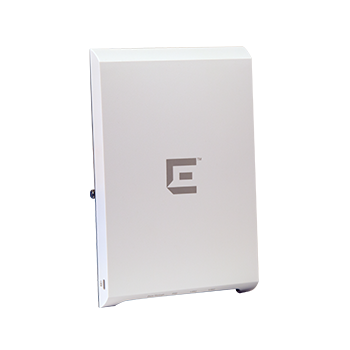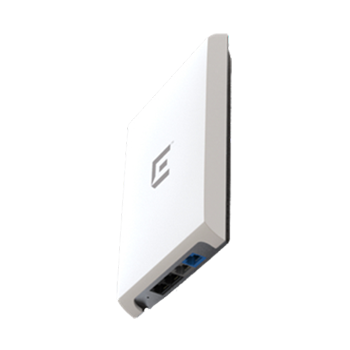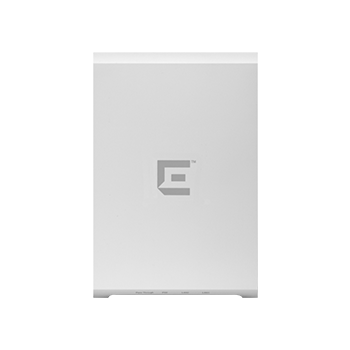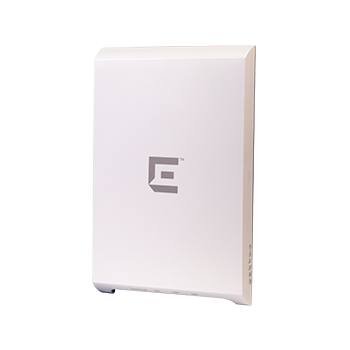Extreme Networks Extreme Wireless AP 3912
Extreme Wireless AP 3912
The AP3912 is a feature rich 802.11ac Wave 2 and 802.11abgn indoor access point that delivers enterprise-grade performance and security for small service areas such as residence halls, patient rooms, or hotel rooms. Although simple to install, the AP3912 offers a range of connectivity options including wired LAN, 2.4/5G WiFi, and wired pass-through and comes future proof with an integrated BLE/802.15.4 radio for connectivity to Internet of Things (IoT) sensors and devices.
The energy efficient AP3912 uses 802.3af Power over Ethernet (PoE) in normal operating mode. For deployments that require powering a wired device upstream such as an IPTV or VOIP phone, the AP3912 can optionally provide 802.3af power to a wired device when powered via 802.3at PoE+ by a downstream switch.
The AP3912 is built using the latest Wi-Fi technology, including 802.11ac Wave 2, dynamic radio management, spectrum analysis with interference classification, beamforming, multi-user MIMO, self-forming and self-healing meshing, security, role-based authentication, authorization, and access control. The 2×2:2 platform is capable of delivering up to 1.2 Gbps over-the-air performance and up to 50,000 packets per second on the wire port.
-
MIMO implementation for high performance
11ac & 11n throughputs 2×2
-
High performance enterprise class AP
YES
-
Internet of Things (IoT) Radio
- Dual mode selectable (2.4 GHz with Co-Existence): Bluetooth Low Energy (BLE) 4.1
- Single and Dual mode operation (Classic and Low Power Profiles 802.15.4 -2011)
-
Maximum Throughput 2.4GHz Radio
300 Mbps
-
Maximum Throughput 5GHz Radio
866 Gbps
-
Maximum Throughput per AP
1.166 Gbps
-
Mode of operation
Semi-autonomous
-
Number of simultaneous users (MU-MIMO)
2
-
Number of spatial streams
2
-
Number of SSIDs supported per radio/total
8/16
-
Number of Wi-Fi radios
2
-
Plug and play operation/Zero touch deployment
YES
-
RFC2285 Wire/Wireless Forwarding Rate
50,000 pps
-
Security and Standards
WPA, WPA2 (AES), 802.11i, 802.1x, IPSec, IKEv2, PKCS #10, X509 DER / PKCS #12, SSL
-
Simultaneous users per radio/total
240/480 Per AP
-
Simultaneous Voice calls
(802.11b, G711, R>80) 30 or less
| Intelligent thin AP | Encryption, Security, QoS and RF management done on AP |
| Distributed and centralized data paths within same SSID | ✓ |
| Application based distributed and centralized data paths within same user/ device session | ✓ |
| Simultaneous RF monitoring and client services | ✓ |
| BYOD/device fingerprinting visibility | ✓ |
| Application/Layer 7 visibility and control | ✓ |
| In-channel WIDS | ✓ |
| In-channel WIPS | ✓ |
| Dedicated multi-channel WIDS (Guardian mode) | ✓ |
| Dedicated multi-channel WIPS (Guardian mode) | ✓ |
| Dedicated multi-channel RF spectrum analysis and fingerprinting | ✓ |
| Locates devices and threats via RF triangulation | ✓ |
| Self-forming and self-healing meshing | ✓ |
| Remote access point | ✓ |
| Hardware-based, end-to-end data and control plane encryption | ✓ |
| Private and public cloud deployments | ✓ |
| SSL | ✓ |
| Policy Enforcement for Wired Clients (L2-L7 Access Control, QoS, Rate Limiting, and VLAN Containment) | ✓ |
| Security scanning and serve clients on same radio | ✓ |
| Security scanning and spectrum analysis on same radio | ✓ |
| Spectrum analysis and serve clients on same radio | ✓ |
| Multi-channel dedicated security scanning and spectrum analysis | ✓ |
| Simultaneous Users (MU-MIMO) | ✓ |
| Radio 1 (5GHz) | 6 dBi |
| Radio 2 (2.4GHz) | 4 dBi |
| Dynamic Channel Control | 802.11h: DFS & TPC support (ETSI) |
| Efficient use of the spectrum with a multi-channel architecture | ✓ |
| Automatic transmit power and channel control | ✓ |
| Self-healing with coverage gap detection | ✓ |
| Band steering with multiple steering modes | ✓ |
| Spectrum load balancing of clients | ✓ |
| Airtime fairness | ✓ |
| Performance protection in congested RF environments | ✓ |
| Fast Transition Roaming (802.11k) | ✓ |
| Mitigates co-channel interference with coordinated access | ✓ |
| Mitigates adjacent channel interference with optimized receive sensitivity | ✓ |
| Efficient reuse of channels at shorter intervals | ✓ |
| Mitigates non 802.11 interference without dedicated radios | ✓ |
| Probe Suppression and client link monitoring | ✓ |
| Management Frame Protection (802.11w) | ✓ |
| Automatic discovery of networks by pre-authenticated devices (802.11u) | ✓ |
| Quality of Service (WMM, 802.11e) | ✓ |
| Power Save (U-APSD) | ✓ |
| Fast secure roaming and handover between APs (802.11r) | ✓ |
| Pre-Authentication (Pre-Auth) | ✓ |
| Opportunistic Key Caching (OKC) | ✓ |
| Bonjour/LLMNR/UPnP identification, containment and control | ✓ |
| Supports voice, video and data using the same SSID | ✓ |
| Prioritizes voice over data for both tagged and untagged traffic | ✓ |
| Rate limiting (rule and user-based) | ✓ |
| Rule and role based QoS processing | ✓ |
| Multicast to unicast Conversion | ✓ |
| Adaptable rate multicast | ✓ |
| Power save mode optimization for multicast | ✓ |
| Media Access Protocol | CSMA/CA with ACK |
| Data Rates | 802.11a: 6, 9, 12, 18, 24, 36, 48, 54 Mbps 802.11b: 1, 2, 5.5, 11 Mbps 802.11g: 1, 2, 5.5, 6, 9, 11, 12, 18, 24, 36, 48, 54 Mbps 802.11 02.11n Performance Table below 802.11ac: See 802.11ac Performance Table below Receiver Sensitivity 802.11a: • -92DdBm @ 6Mbps • -77DdBm @ 54Mbps 802.11g: • -91DdBm @ 6Mbps • -78DdBm @ 54Mbps 802.11n: See 802.11n Receiver Sensitivity Table below 802.11ac: See 802.11ac Receiver Sensitivity Table below |
| Frequency Bands | 802.11ac/a/n: • • • • 5.15 to 5.25 GHz (FCC/IC/ETSI) 5.25 to 5.35 GHz (FCC/IC/ETSI)* 5.47 to 5.725 GHz (FCC/IC/ETSI)* 5.725 to 5.850 GHz (FCC/IC) 802.11b/g/n: • 2.400 to 2.4720 GHz (FCC/IC) • 2.400 to 2.4835 GHz (ETSI) *FCC/IC DFS certification in progress |
| Wireless Modulation | 802.11ac: BPSK, QPSK, 16QAM, 64QAM, 256QAM with OFDM 802.11ac Packet aggregation: A-MPDU, A-MSDU 802.11ac Very High- Throughput (VHT): VHT20/40/80 802.11ac Advanced Features: LDPC, STBC, Maximum Likelihood (ML) Detection 802.11n: BPSK, QPSK, 16QAM, 64QAM with OFDM 802.11n High-throughput (HT) support: HT 20/40 802.11n Packet aggregation: A-MPDU, A- MSDU 802.11n Advanced Features: LDPC, STBC and TxBF 802.11a: BPSK, QPSK, 16QAM, 64QAM with OFDM 802.11g: DSSS and OFDM 802.11b: DSSS BLE: GFSK 802.15.4: O-QPSK |
| Uplink (Backplate) | 1x 10/100/1000 Mbps autosense Ethernet port 1 x 10/100/1000 Mbps Pass-through port |
| Client Ports | 3 x 10/100/1000 Mbps autosense Ethernet ports Port 1 is PSE – Provides 802.3af PoE/ Requires 802.3at power source 1 x 10/100/1000 Mbps Pass-through port (connectivity provided by backend switch) |
| Integrated Wall Mounting | ✓ |
| Single/Dual Gang (Junction) box installation | ✓ |
| Environmental | Operating: Temperature 0° C to +40 ° C (+32° F to +104° F) Humidity 0%-95% (noncondensing) Storage: Temperature -50° C to +70° C (-58° F to +158° F) Transportation: Temperature -50° C to +70° C (-58° F to +158° F) |
| Compliance | FCC CFR 47 Part 15, Class B ICES-003 Class B FCC Subpart C 15.247 FCC Subpart E 15.407 RSS-210 EN 301 893 EN 300 328 EN3014891&17 EN50385 EN 55022 (CISPR 22) EN 60601-1-2 AS/NZS4268 + CISPR22 |
| Safety | IEC 60950-1 EN 60950-1 UL 60950-1 CSA 22.2 No.60950-1-03 AS/NZS 60950.1 |




